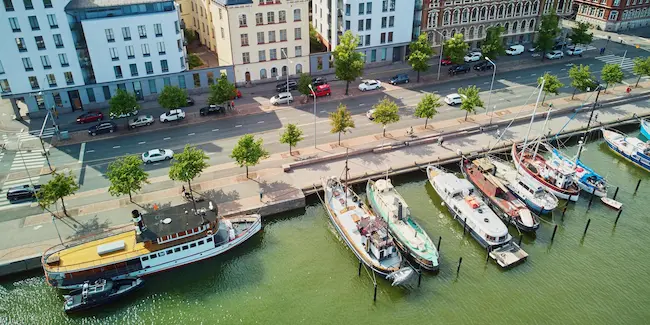Have you ever marveled at the towering smokestacks of an old factory? Industrial tourism opens the doors to these intriguing worlds offering travelers a behind-the-scenes look at America’s rich industrial heritage. In this article, we’ll explain the fascinating realm of industrial tourism in the United States. Uncovering hidden gems and shedding light on these industrial wonders’ economic cultural, and historical significance.

Understanding Industrial Tourism in the United States
What is Industrial Tourism?
Industrial tourism, also known as industrial heritage tourism. It involves visiting locations linked to the industries that have shaped a region’s identity and economy. It allows travelers to explore manufacturing processes. Historical sites, and regional specialties, offering a unique blend of education, entertainment, and exploration.
Rise of Industrial Tourism in America
Industrial tourism in the United States can be traced back to the country’s industrial revolution in the late 19th and early 20th centuries. As factories and manufacturing facilities increased across the nation. People became increasingly curious about the inner workings of these industrial behemoths.
In recent years, there has been a resurgence of interest in industrial tourism, driven by a desire for authentic experiences and a growing appreciation for America’s industrial heritage’s historical and cultural significance. Travelers are drawn to the nostalgia of abandoned factories, manufacturing museums’ ingenuity, and industrial district revitalization.
Exploring Industrial Heritage Sites
America is home to many industrial heritage sites offering insights into the country’s industrial past. From abandoned factories to meticulously preserved museums, these sites glimpse the nation’s manufacturing history and impact on society.
Notable Industrial Heritage Sites
- Detroit, Michigan: Once the heart of America’s automotive industry, Detroit is home to iconic factories such as the Ford Piquette Avenue Plant and the Henry Ford Museum of American Innovation.
- Lowell, Massachusetts: Known as the birthplace of the American Industrial Revolution, Lowell boasts historic textile mills and a thriving industrial museum district.
- Pittsburgh, Pennsylvania: With its rich history of steel production, Pittsburgh offers visitors the chance to explore abandoned steel mills and learn about the city’s industrial heyday.
Industrial Tours: Behind-the-Scenes Experiences
For travelers eager to go beyond the surface and gain firsthand knowledge of industrial processes, guided tours offer an immersive experience like no other. Industrial tours provide access to manufacturing facilities, energy production sites, and other industrial landmarks, allowing visitors to witness production in action and interact with industry professionals.
Popular Industrial Tours in the US
- Brewery Tours: From craft breweries to large-scale production facilities, brewery tours offer beer enthusiasts the chance to see how their favorite brews are made and sample a variety of offerings.
- Factory Visits: Automotive plants, technology companies, and other manufacturing facilities often offer guided tours that showcase their production processes and innovations.
- Energy Production Facilities: Wind farms, hydroelectric dams, and solar power plants welcome visitors interested in learning about renewable energy and sustainable practices.
Regional Industrial Specialties
America’s diverse landscape is reflected in its regional industrial specialties, with each state boasting unique industries and manufacturing traditions. From aerospace in California to automotive in Michigan, these regional specialties offer travelers a glimpse into different regions’ economic and cultural fabric.
Unique Industries Across the US
- California: Silicon Valley’s tech giants lead the way in innovation, while Los Angeles and San Diego aerospace companies propel the state’s aerospace industry to new heights.
- Michigan: The Motor City, Detroit, is synonymous with automotive manufacturing, with iconic brands like Ford, General Motors, and Chrysler calling the state home.
- Texas: Oil and gas production dominate the industrial landscape in Texas, with sprawling refineries and drilling operations dotting the state’s vast plains.
Economic Impact and Revitalization
Industrial tourism provides travelers with memorable experiences and contributes to local communities’ economic vitality. Industrial tourism is crucial in revitalizing former industrial areas and supporting sustainable development initiatives by attracting visitors, generating revenue, and preserving historic sites.
Success Stories of Industrial Tourism
- Steelstacks in Bethlehem, Pennsylvania: Once home to Bethlehem Steel, the Steelstacks site has been transformed into a cultural and entertainment destination featuring museums, performance venues, and outdoor recreation areas.
- The Heinz History Center in Pittsburgh, Pennsylvania: This museum celebrates Pittsburgh’s industrial heritage and showcases the city’s contributions to American industry, innovation, and culture.
Challenges and Conservation Efforts
While industrial tourism offers valuable insights into America’s industrial past, it poses challenges related to preservation, environmental impact, and sustainability. Conservation efforts and community initiatives play a crucial role in protecting industrial heritage sites and ensuring that future generations can continue to explore and appreciate America’s industrial legacy.
Conservation Efforts in Action
The National Trust for Historic Preservation
This nonprofit organization works to preserve and protect America’s historic places. Including industrial heritage sites like textile mills, factories, and manufacturing districts.
Community-Led Initiatives
From grassroots advocacy groups to local historical societies. Communities nationwide are mobilizing to safeguard industrial landmarks and promote responsible tourism practices.
Conclusion
In conclusion, industrial tourism provides an unparalleled opportunity to uncover the rich tapestry of America’s industrial heritage. With diverse experiences ranging from factory tours to historical landmarks, there’s something to captivate every traveler. The inner workings of manufacturing processes and exploring the cultural significance of industrial sites. Visitors gain a deeper understanding of the forces that have shaped our nation’s identity.
Embarking on an industrial adventure allows travelers to connect with the ingenuity, innovation, and resilience that define American industry. From the steel mills of Pittsburgh to the tech hubs of Silicon Valley. Each destination offers a unique insight into its region’s economic and cultural fabric. Moreover, industrial tourism plays a crucial role in supporting local economies. Revitalizing former industrial areas, and preserving our industrial heritage for future generations.
So whether you’re a history enthusiast, a curious explorer, or simply seeking new experiences, consider embarking on an industrial journey.
FAQs
What exactly is industrial tourism?
Industrial tourism, or industrial heritage tourism, involves visiting locations associated with various industries in a particular region.
What types of experiences can I expect from industrial tourism?
Industrial tourism offers tours of manufacturing facilities, visits to historic industrial sites and museums, and immersive encounters with regional specialties. You might explore abandoned factories, witness production processes in action, or learn about different industries’ cultural and economic significance.
Why should I consider exploring industrial sites?
Industrial sites offers several compelling reasons to explore these unique destinations:
It provides a fascinating glimpse into America’s industrial heritage, allowing you to appreciate the ingenuity.
Industrial tourism can be an enriching educational experience, offering insights into how products are made.
Visiting industrial sites can contribute to the economic revitalization of local communities, supporting heritage preservation and sustainable development initiatives.


